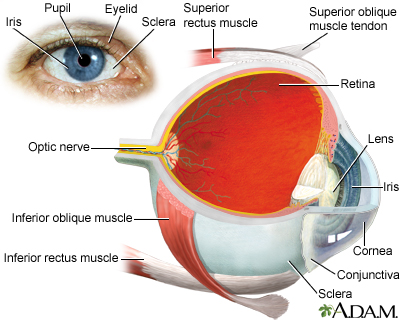Ectropion
Ectropion is the turning out of the eyelid so that the inner surface is exposed. It most often affects the lower eyelid.

The eye is the organ of sight, a nearly spherical hollow globe filled with fluids (humors). The outer layer or tunic (sclera, or white, and cornea) is fibrous and protective. The middle layer (choroid, ciliary body and the iris) is vascular. The innermost layer (the retina) is nervous or sensory. The fluids in the eye are divided by the lens into the vitreous humor (behind the lens) and the aqueous humor (in front of the lens). The lens itself is flexible and suspended by ligaments which allow it to change shape to focus light on the retina, which is composed of sensory neurons.
Causes
Ectropion is very often caused by the aging process. The connective (supporting) tissue of the eyelid becomes weak. This causes the lid to turn out so that the inside of the lower lid is no longer against the eyeball. It can also be caused by:
- A defect that occurs before birth (for example, in children with Down syndrome)
- Facial muscle weakness
- Scar tissue from burns or injuries
Symptoms
Symptoms include:
- Dry, painful eyes
- Excess tearing of the eye (epiphora)
- Eyelid turns outward (downward)
- Long-term (chronic) conjunctivitis
- Keratitis
- Redness of the lid and white part of the eye
If you have ectropion, you will most likely have excess tearing. This happens because the eye gets dry, then makes more tears. The excess tears can't get into the tear drainage duct. Therefore, they build up inside the lower lid and then spill over the edge of the lid onto the cheek.
Exams and Tests
The health care provider will make a diagnosis by doing an exam of the eyes and eyelids. Special tests are not needed most of the time.
Treatment
Artificial tears (a lubricant) may ease dryness and keep the cornea moist. Ointment may be helpful when the eye can't close all of the way, such as when you are asleep.
Surgery is very often effective. When ectropion is related to aging or paralysis, the surgeon can tighten the muscles that hold the eyelids in place. If the condition is due to scarring of the skin, a skin graft or laser treatment may be used. The surgery is most often done in the office or at an outpatient surgery center. A medicine is used to numb the area (local anesthesia) before the surgery.
Outlook (Prognosis)
The outcome is very often good with treatment.
Possible Complications
Corneal dryness and irritation may lead to:
- Corneal abrasions
- Corneal ulcers
- Eye infections
Corneal ulcers can cause vision loss.
When to Contact a Medical Professional
Make an appointment with your provider if you have symptoms of ectropion.
If you have ectropion, get emergency medical help if you have:
- Vision that is getting worse
- Pain
- Sensitivity to light
- Eye redness that is getting worse quickly
Prevention
Most cases cannot be prevented. You may want to use artificial tears or ointments to prevent injury to the cornea, especially if you are waiting for a more permanent treatment.
References
Cioffi GA, Liebmann JM. Diseases of the visual system. In: Goldman L, Cooney KA, eds. Goldman-Cecil Medicine. 27th ed. Philadelphia, PA: Elsevier; 2024:chap 391.
Maamari RN, Couch SM. Ectropion. In: Yanoff M, Duker JS, eds. Ophthalmology. 6th ed. Philadelphia, PA: Elsevier; 2023:chap 12.6.
Olitsky SE, Marsh JD. Abnormalities of the lids. In: Kliegman RM, St. Geme JW, Blum NJ, et al, eds. Nelson Textbook of Pediatrics. 22nd ed. Philadelphia, PA: Elsevier; 2025:chap 664.
Version Info
Last reviewed on: 7/9/2024
Reviewed by: Audrey Tai, DO, MS, Athena Eye Care, Mission Viejo, CA. Also reviewed by David C. Dugdale, MD, Medical Director, Brenda Conaway, Editorial Director, and the A.D.A.M. Editorial team.
